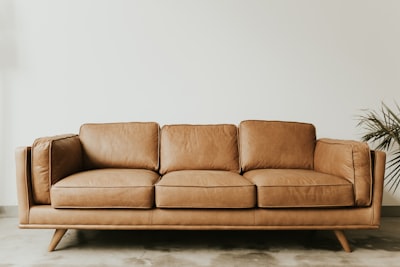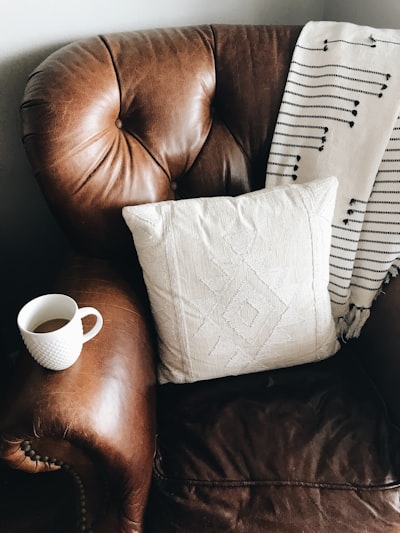Interior Design - Inspiration - Furniture Tips and more
Easy Ways to Care for Your Leather Sofa
Your leather sofa is more than just a piece of furniture. It's the centerpiece of your living room, the place where you relax after a long day, and where you entertain friends and family. However, with great use comes great responsibility. Leather sofas a degree of care to maintain their beauty and functionality over time. In this blog, we will go over everything you need to know about caring for your leather sofa. From understanding the different types of leather used in sofas to preventing damage and dealing with spills, we have got you covered. We will also debunk some common myths surrounding leather sofas and weigh the pros and cons of investing in one. So sit back, relax, and read on to learn how to make your leather sofa last for years to come.
Understanding Your Leather Sofa
When choosing a leather sofa, consider the type of leather and its impact on comfort and appearance. Understanding the leather type is crucial for maintenance, as it sets the tone for your living space. The quality of leather determines durability and comfort, making it a perfect choice for your living room.
Types of Leather Used in Sofas
Understanding the wide range of genuine leather types available for sofas is essential for interior design choices. Consider full grain leather for its luxurious appearance, or Italian leather for premium quality and comfort. Aniline leather is a perfect choice for everyday living with its statement pieces.
The Durability Factor of Leather Sofas
When it comes to real leather sofas, durability is a key factor. Quality leather ensures that your sofa maintains its appearance and comfort even with everyday use. With proper care and maintenance, a leather couch can last up to 4 times longer than a faux leather alternative. The protective finish on semi-aniline leather increases its resistance to wear and tear, making it a worthwhile investment in your home.
Essential Care Tips for Leather Sofas
Regular maintenance is key to preserving the luxurious look and comfort of your leather sofa. Conditioning the leather is essential for its overall appearance and feel. It's important to know the type of leather used in your sofa for proper care and maintenance, ensuring that your real leather sofa lasts for years.
Regular Cleaning: A Must for Leather Sofas
Proper maintenance is crucial to uphold the exquisite appeal and comfort of your leather sofa. Regular wiping and occasional conditioning are sufficient for upkeep, while dusting prevents dirt buildup and scratches. Upholstery cleaning products are available for easy care, ensuring that your leather sofa remains a perfect choice for everyday use.
Importance of Conditioning Your Leather Sofa
Conditioning ensures maintenance of its luxurious appearance and overall comfort. It contributes to durability, prevents signs of wear, and maintains the suppleness of the leather. Different leather types require specific conditioning methods for optimal care and longevity.
Preventing Damage to Your Leather Sofa
Protecting your leather sofa from sunlight and heat is essential to preserve its appearance and comfort. Avoid placing sharp objects near the sofa to prevent upholstery damage. Act promptly to address spills and stains, preventing lasting harm to the leather.
Protecting Leather from Sunlight and Heat
To preserve the quality of your leather sofa, shield it from direct sunlight to prevent fading and cracking. Also, avoid placing it near heat sources like radiators or fireplaces, which can dry out and damage the leather. By doing so, you ensure that your leather sofa maintains its comfort and appearance for years to come.
Keeping Sharp Objects Away
To safeguard your leather sofa, keeping sharp items at bay is crucial in preventing upholstery damage. Items such as scissors and keys can easily cause scratches or tears. Additionally, refrain from placing sharp-edged furniture near the sofa to maintain its pristine condition
Dealing with Spills on Your Leather Sofa
Promptly attending to spills on your leather sofa is vital for preventing stains and upholding its appearance. The use of appropriate leather cleaning products ensures spill removal while maintaining overall comfort.
Immediate Actions for Liquid Spills
Regular upkeep and conditioning are vital to prevent future spills from seeping into the leather. Start by blotting the spill with a dry cloth to soak up as much liquid as possible. Then, use a recommended leather cleaner to eliminate any remaining residue. Let the area air-dry naturally, avoiding direct heat or sunlight. For deeply penetrated spills, consult a professional leather cleaner.
Handling Grease Stains
Gently pat the grease stain with a fresh, dry cloth to soak up excess oil. Apply a small quantity of talcum powder or cornstarch to the affected area to absorb the remaining grease. After 2-3 hours, delicately brush off the powder and wipe the area with a leather cleaner. Refrain from using water or liquid cleaners directly on the stain, as they may spread the grease. If the stain persists, seek professional assistance to prevent damage to the leather.
Leather Sofa Myths Debunked
Maintaining leather sofas is manageable with diligent care routines, debunking the myth that they are hard to maintain. Additionally, with the application of protective measures, leather sofas can effectively withstand daily use, including the presence of pets. Embracing proper maintenance transforms leather sofas into pet-friendly and durable furniture options.
Myth 1: Leather Sofas Are Hard to Maintain
Maintaining a leather sofa is easier than you think. Real leather sofas are typically resistant to spills and dirt, making them easy to clean and maintain. The durability of leather sofas allows them to withstand wear and tear, making them a long-lasting seating option. Cleaning and conditioning your leather sofa regularly are essential to keep it looking like new. It's another myth that scratches on leather are permanent – in fact, minor scratches can be buffed out with a leather conditioner or a specialised repair kit. With proper care and maintenance routines, leather sofa upkeep becomes easy and manageable for homeowners.
Myth 2: Leather Sofas Are Not Pet-Friendly
Contrary to popular belief, leather sofas can indeed coexist harmoniously with pets. They are easy to clean and maintain, as they do not trap dust, allergens, or pet hair like fabric sofas do. With proper care, leather sofas can be suitable for households with pets. Naturally, precautions should be taken to protect leather sofas from scratches and spills in households with pets, and some leathers are more resistant to pet damage than others. Regular maintenance, such as wiping down with a damp cloth and using leather conditioner, can help prevent scratches if your pet sits on the sofa. Adding a throw on the sofa as a protective cover for your pet to lay on will further ensure a beautiful and pet-friendly living space.
Investing in a Leather Sofa: Pros and Cons
When considering investing in a leather sofa, it's important to weigh the pros and cons. The unparalleled comfort, durability, and timeless aesthetic appeal make it a worthwhile investment for modern living spaces. Understanding these aspects can guide informed purchasing decisions, ensuring customer satisfaction.
Advantages of Owning a Leather Sofa
Owning a leather sofa presents a touch of sophistication, elevating the living area's ambiance. The durability of genuine leather sofas ensures a lifespan of 10 to 15 years with proper maintenance, surpassing faux leather alternatives by up to 4 times. Maintenance is effortless, requiring only a simple wipe-down due to the material's easy cleaning nature. Additionally, the timeless, classic look of leather sofas never goes out of style and can be a smart long-term investment over less durable options, offering peace of mind with proper care. Moreover, as leather sofas age, they develop a unique patina, adding to their charm and value, making them a worthwhile investment for homeowners.
Potential Drawbacks of Leather Sofas
Although leather sofas exude a timeless sophistication, they tend to be at least 2 times more expensive compared to fabric alternatives. It is imperative to properly maintain and care for them in order to avoid damage caused by sharp objects, pet claws, and exposure to sunlight. Additionally, there is a limited range of colours available to choose from compared to fabric upholsteries. However, despite these downsides, a well-preserved leather sofa has the potential to serve as a striking focal point in any living room.
Making Your Leather Sofa Last: Final Thoughts
Proper care ensures durable, timeless leather sofas that can withstand daily use. Regular conditioning maintains natural luster and softness, while keeping them away from direct heat sources is essential. Choosing real leather offers elegance and durability, enhancing the aesthetic of your living space. Quality leather sofas are a long-term investment.
Why Caring for Your Leather Sofa Matters
Caring for your leather sofa ensures its longevity, maintaining its newness and premium quality. Regular cleaning and conditioning preserve its luxurious materials, protecting your valuable investment. Investing time and effort in caring for your leather sofa is crucial for long-lasting, customer satisfaction.
How often should you condition a leather sofa?
Conditioning your leather sofa every 6-12 months helps maintain its quality and comfort. The frequency of conditioning depends on the type of leather and how often the sofa is used. Aniline leather sofas may require more frequent conditioning, while daily use may necessitate more regular care. Proper conditioning ensures a well-maintained and comfortable leather sofa.
What kind of leather is best for a sofa?
Full-grain leather is considered the best option for sofa upholstery. It is the most durable and highest quality leather, as it is made from the top layer of the hide which retains its natural texture and imperfections. Full-grain leather ages beautifully and develops a rich patina over time.
Conclusion
To make your leather sofa last for years to come, it's important to understand its unique characteristics and follow proper care and maintenance. Regular cleaning and conditioning are essential to keep the leather soft, supple, and free from damage. Preventing damage by protecting it from sunlight, heat, and sharp objects is also crucial. In case of spills, immediate action is necessary to minimise stains. There are also some common myths about leather sofas that need to be debunked. While owning a leather sofa has its advantages, such as durability and elegance, there are also potential drawbacks to consider. Ultimately, caring for your leather sofa ensures its longevity and preserves its beauty. So start implementing these easy care tips today and enjoy your leather sofa for years to come.




















